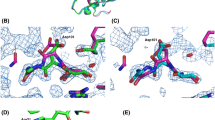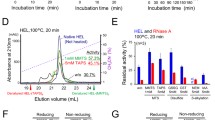Abstract
Lysozyme refolding with high yields sometimes results from incomplete denaturation. Dithiothreitol (DTT) is a reductant commonly used to reduce and unfold disulfide-stabilized lysozymes. Through the use of fluorescence spectroscopy to access the extent of denaturation, we found that the rate and extent of denaturation highly depended on the concentration of DTT. Further, the denaturation exhibited a two-phase transition at a high DTT concentration with DTT at >100 mM and long denaturation time (>24 h) being needed for complete denaturation. A low DTT concentration and a short denaturation time resulted in fast refolding with high activity recovery, while a high DTT concentration and a long denaturation time resulted in slow refolding with low activity recovery. Hence, the renaturation of disulfide-containing lysozyme was highly affected by the extent of denaturation.





Similar content being viewed by others
References
Batas B, Chaudhuri JB (1995) Protein refolding at high concentration using size-exclusion chromatography. Biotechnol Bioeng 50:1–23
Buswell AM, Middelberg APJ (2002) Critical analysis of lysozyme refolding kinetics. Biotechnol Prog 18:470–475
Chang CK, Liu HS (2006) Step change of mobile phase flow rate to enhance protein folding in size exclusion chromatography. Biochem Eng J 29:2–11
Copeland RA (1993) Methods for protein analysis: a practical guide to laboratory protocols. Chapman and Hall, New York
Dong XY, Wang Y (2002) Size exclusion chromatography with an artificial chaperone system enhanced lysozyme renaturation. Enzyme Microb Technol 30:792–797
Gu Z, Su Z (2001) Urea gradient size-exclusion chromatography enhanced the yield of lysozyme refolding. J Chromatogr A 918:311–318
Hevehan DL, Clark EDB (1996) Oxidative renaturation of lysozyme at high concentration. Biotechnol Bioeng 54:221–230
Katoh S, Katoh Y (2000) Continuous refolding of lysozyme with fed-batch addition of denatured protein solution. Process Biochem 35:1119–1124
Ladokhin AS (2000) Fluorescence spectroscopy in peptide and protein analysis. In: Meyers RA (ed) Encyclopedia of analytical chemistry: applications, theory, and instrumentation. John Wiley & Sons, pp 5762–5779
Lanckriet H, Middelberg APJ (2004) Continuous chromatographic protein refolding. J Chromatogra A 1022:103–113
Li JJ, Liu YD (2004) Hydrophobic interaction chromatography correctly refolding proteins assisted by glycerol and urea gradient. J Chromatogr A 1061:193–199
Lu D, Zhang M (2005) The mechanism of PNIPAAm-assisted refolding of lysozyme denatured by urea. Biochem Eng J 24:55–64
Lu D, Wang J, Liu Z (2005) How CTAB assists the refolding of native and recombinant lysozyme. Biochem Eng J 24:267–277
Lu D, Zhang M (2006) Dextran-grafted-PNIPAAm as an artificial chaperone for protein refolding. Biochem Eng J 27:226–343
Panda M, Horowitz PM (2000) Active-site sulfhydryl chemistry plays a major role in the misfolding of urea-denatured rhodanese. J Protein Chem 19:399–409
Raman B, Ramakrishna T (1996) Refolding of denatured and denatured/reduced lysozyme at high concentrations. J Biol Chem 271:17067–17072
Shimizu H, Fujimoto K (2000) Improved refolding of denatured/reduced lysozyme using disulfide-carrying polymeric microspheres. Colloids Surf B 18:137–144
Terashima M, Suzuki K (1995) Effective refolding of fully reduced lysozyme with a flow-type reactor. Process Biochem 31:341–345
Touch V, Hayakawa S, Saitoh K (2004) Relationships between conformational changes and antimicrobial activity of lysozyme upon reduction of its disulfide bonds. Food Chem 84:421–428
Acknowledgements
This study was financially supported by the National Science Council, Taiwan (NSC94-2214-E-008-002 and NSC93-2214-E-002-034) and the Center-of-Excellence Program on Membrane Technology, the Ministry of Education, Taiwan.
Author information
Authors and Affiliations
Corresponding author
Rights and permissions
About this article
Cite this article
Lin, JL., Ruaan, RC. & Hsieh, HJ. Refolding of partially and fully denatured lysozymes. Biotechnol Lett 29, 723–729 (2007). https://doi.org/10.1007/s10529-007-9320-y
Received:
Revised:
Accepted:
Published:
Issue Date:
DOI: https://doi.org/10.1007/s10529-007-9320-y




